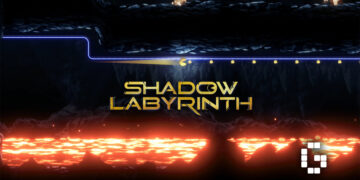During our time at gamescom asia 2023, we had the opportunity to speak with Bobby Gao from NebulaJoy about the upcoming Devil May Cry: Peak of Combat, a game set to bring the stylish hack-and-slash onto mobile devices.

Bobby Gao is the CEO and Founder of NebulaJoy, a China-based company that has put out games such as One Piece: Burning Will, the Degenerate series, and more. He is also the producer of Devil May Cry: Peak of Combat, a mobile entry that aims to inherit the stylish combat of the series.
Joining him in the interview is Li Bian, the Managing Director at Capcom Singapore.
Interview was edited for clarity.

Your achievements are quite spectacular and have gotten NebulaJoy publicly listed within 2 years of starting up the company, as well as winning multiple awards for leadership. What would you say is the most important trait for that kind of growth?
Bobby Gao: First of all, I would say that we are lucky because we have the growth of the internet. There is definitely a lot of challenge for us to do great work for the likes of Bandai Namco and Capcom.
There is also a reason why we are developing a Devil May Cry game. You know? In the past, we mainly focused our efforts on IP-based games. Before Devil May Cry, our previous famous work was One Piece: Burning Will.
Our team is very good at recovering and capturing the original taste of those IPs. We have spent a lot of time and money on these types of games. Because of these efforts, we have successfully made our company publicly listed several years ago.
Of course, now we face the challenge of figuring out how to restore the essence of Devil May Cry. It is much more difficult for us than in previous works. It is something we are working on.

There has been a huge pivot in mobile games in the past 10 years, with expectations moving away from casual experiences to more intricate and in-depth gameplay. Do you think we’ll ever hit a point where mobile action games are just as complex as console releases?
Bobby Gao: I would agree and say they have become more and more similar. However, it is still different because you play console games using a gamepad while mobile games do not use one.
Another thing to note is that there are more general users on mobile devices than there are on consoles. As such, it is quite necessary to simplify the controls, otherwise, general users would just walk away.

Considering how mechanically demanding the Devil May Cry series is known, how did you decide which features need to be included in Peak of Combat?
Bobby Gao: The most important thing in Devil May Cry is the midair combo. Players need to be able to jump and evade in the air, so we chose to restore that system. Beyond restoring the complexity of the required mechanic, you would also need to somehow simplify the controls.
The core players in Devil May Cry are able to perform up to the SSS Stylish combo, but it is something you have to allow general users to be able to achieve as well.

The tag mechanic is something we’ve never seen in Devil May Cry before. Could you tell us more about the concept behind character switching and how it adds depth to combat?
Bobby Gao: The reason why we simplified Devil May Cry is because the game is quite complex. Originally, each character had numerous skills. To simplify it, we came up with the idea of character switching.
Not only does this make the game far less complex, but also addresses the issue of control complexity. Now, instead of a character having 10 skills, we’ve reduced them to around 4 to 5 abilities per character, which then can be accessed by switching between characters.
Another reason for these changes is the limitations of mobile devices. If a character has too many abilities, it would consume a lot of memory. Therefore, we divided these skills among different characters while retaining many of the original ideas. This allows us to maintain the essence of Devil May Cry while facilitating character switching and operation as in the original game.

Earlier this year, you worked with Hideaki Itsuno to ensure that Peak of Combat feels authentic to the series. Would you mind sharing some of the feedback he gave?
Bobby Gao: Itsuno-san is the previous director of Devil May Cry, so he has an in-depth understanding of the series. He has provided us with guidance on what should and shouldn’t be done. For instance, he emphasized that Dante should never be knocked down as he possesses a certain demonic power that prevents him from falling like an ordinary person, and this attention to detail is crucial.
We constantly engaged in discussions about what elements should be retained and what might need to be adapted to suit the mobile platform and introduce innovations. These were topics that we frequently debated.
Additionally, I would like to express my gratitude to our colleagues at Capcom, including the heads of the development team, for their support. They have provided us with ample creative and artistic freedom, enabling us to experiment with many ideas that were not present in the original game when creating a mobile game.

Even though Nero is not around during the supposed timeline of Peak of Combat, it is still great to see him becoming playable. Does this mean we can expect plenty of other characters coming in the future?
Bobby Gao: Yes, Nero is just one of them. Seeing that we have Nero now, in fact, in the future, we will have other characters like V and even the characters from the fifth installment. This is all part of our planning, and they will be continually updated with version updates, bringing new characters and new stories.

What is your favorite title in the Devil May Cry series?
Bobby Gao: I love Devil May Cry 5 the most. I started with Devil May Cry 4, then moved on to Devil May Cry 3, followed by Devil May Cry 5.

Considering how much mobile games have become more and more like console titles. Does Capcom think that there is a future for premium mobile games instead of free-to-play ones with gacha mechanics?
Li Bian: This is a complex question, especially considering the concept of cloud gaming and the fact that mobile devices can now run cloud games, which are typically billed on an hourly basis. It offers an alternative way to enjoy games. With today’s smartphones, as in the case of titles like Devil May Cry, they can perform exceptionally well, and you can even cast them onto larger screens. In the future, we might see a trend where you mainly use your TV or larger screens for games streamed from a mobile.
From our perspective, it’s not necessarily a matter of mobile gaming with Premium replacing other forms of gaming. Instead, it’s about offering users more diverse ways to experience games. As for making Premium mobile games, we might continue doing that. Take something like Monster Hunter Now for example, which also has a lighter mobile version. We’re always looking to explore and adapt to different platforms, and a title like “Devil May Cry” follows a similar approach.
In simple terms, my understanding is that it’s not a matter of one replacing the other; it’s about the emergence of various payment models, including free and premium options, giving players more freedom to choose how they want to experience their games. This diversity in the gaming industry is likely to grow over time.

How does Capcom ensure the game stays as close as the original?
Li Bian: This can only be achieved through extensive discussions between the two teams, as there are many details to consider, and it’s challenging to remember them all at once. The key is that during the development process, the two teams consistently engage in discussions.
Preserving the essence of the original work is not something that can be done overnight. Because we are two separate companies, the alignment between our teams is crucial. As Bobby mentioned earlier, details like Dante never falling completely but always having a hand to support himself when knocked down are part of this culture. These aspects are tested and tried to see if they work, and if not, they are revised.

It involves a continuous refinement of details, like how a character jumps or turns, the timing of Dante’s double jump, or the height of the first and second jumps. These are finer details that may not be as meticulously considered in game development in some regions, but we are particularly attentive to such nuances in our team.
When it comes to broader concepts and artistic elements, those are relatively straightforward to see. However, these smaller details can be overlooked, and the importance of these details might not be as evident to other teams. For us, these details are crucial. It’s through this meticulous process of accumulation and refinement that we can retain the essence of the original work and stay true to it.

Do you have anything else you would to share with the fans?
Li Bian: I believe that Devil May Cry is an important endeavor for us. It’s a product that we’ve spent a significant amount of time and effort on, approximately six to seven years, and it has gone through many iterations. As a result, we highly value player feedback.
We aim to recapture the essence of the original game, so player input is invaluable to us. We hope that the media and players can provide us with more feedback, and we welcome everyone to engage with us on social media.
There will be many updates in the future, and we plan to gradually reintroduce characters from the series’ history. Our ultimate goal is to faithfully recreate the essence of the Devil May Cry franchise.

Our interview concludes here. We would like to thank Bobby Gao and Li Bian for taking the time to answer our questions regarding Devil May Cry: Peak of Combat and related topics.
Devil May Cry: Peak of Combat is now available for pre-registration and will be released for Android and iOS devices. No official release date has been announced yet.














![[ASIA EXCLUSIVE] Bringing Back a Classic: Inside the Making of FINAL FANTASY TACTICS – The Ivalice Chronicles](https://cdn.gamerbraves.com/2025/06/FFT-Ivalice-Chronicles_Interview_FI2-360x180.jpg)


![[EXCLUSIVE] Gearbox Executives Share Details on Borderlands 4 – Story, Weapons, and Lessons Learned](https://cdn.gamerbraves.com/2025/06/Borderlands-4_Interview_FI-360x180.jpg)
![[EXCLUSIVE] Wan Hazmer Reveals How No Straight Roads 2 Expands Beyond Vinyl City with Shueisha Games](https://cdn.gamerbraves.com/2025/06/NSR2_Interview_FI-360x180.jpg)
![[gamescom asia 2023] Producer Bobby Gao & Capcom’s Li Bian Talks About Retaining the DMC Stylish Essence in Devil May Cry: Peak of Combat](https://cdn.gamerbraves.com/2023/10/Featured-Image-Devil-May-Cry-Peak-of-Combat-gamescon-asia-interview-750x392.jpg)









